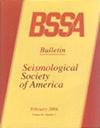A Statistical Approach to Estimate Seismic Monitoring Stations’ Biases and Error Levels
IF 2.9
3区 地球科学
Q2 GEOCHEMISTRY & GEOPHYSICS
引用次数: 0
Abstract
Magnitudes are common and important measures for the size of seismic events. The International Data Centre (IDC) of the Comprehensive Nuclear-Test Ban Treaty Organization estimates an event magnitude by averaging the magnitudes calculated by individual stations that detected the event, excluding outliers. This approach assumes that all station magnitudes have the same error level and are unbiased, namely, they have no systematic errors. We show that the body-wave and surface-wave magnitudes published in the Reviewed Event Bulletin (REB) of the IDC are inconsistent with these assumptions. We thus consider a model where each station has an unknown bias and error level. Given a large collection of reported event magnitudes by a network of monitoring stations, we propose a novel approach to estimate each individual station’s bias and error level. From a statistical perspective, this is a challenging problem involving a huge number of variables, because in addition to the stations’ biases and error levels, the event magnitudes are also unknown. Our approach is based on analyzing differences between reported magnitude values at pairs of stations, which cancels out the unknown event magnitudes and allows us to derive a simple and computationally efficient algorithm. We use the estimated station biases as station correction terms and the estimated error levels to compute weights for event magnitude estimation. Using a large data set from the REB with millions of reported station magnitudes, we show that our approach yields more consistent station and event magnitudes.估计地震监测站偏差和误差水平的统计方法
震级是衡量地震事件大小的常用而重要的指标。全面禁止核试验条约组织的国际数据中心(IDC)通过对探测到该事件的各个台站计算的震级进行平均,排除异常值,来估计事件的震级。该方法假定所有站点的震级具有相同的误差水平并且是无偏的,即它们没有系统误差。我们表明,在国际数据中心的回顾事件公报(REB)上发表的体波和面波震级与这些假设不一致。因此,我们考虑一个模型,其中每个站点都有未知的偏差和误差水平。鉴于监测站网络报告的大量事件震级,我们提出了一种新的方法来估计每个监测站的偏差和误差水平。从统计学的角度来看,这是一个涉及大量变量的具有挑战性的问题,因为除了气象站的偏差和误差水平之外,事件的震级也是未知的。我们的方法基于对台站报告震级值之间的差异进行分析,从而消除了未知事件的震级,并使我们能够推导出一种简单且计算效率高的算法。我们使用估计的台站偏差作为台站校正项,并使用估计的误差水平来计算事件震级估计的权重。使用来自REB的大型数据集,其中包含数百万个报告的台站震级,我们表明我们的方法产生了更一致的台站和事件震级。
本文章由计算机程序翻译,如有差异,请以英文原文为准。
求助全文
约1分钟内获得全文
求助全文
来源期刊

Bulletin of the Seismological Society of America
地学-地球化学与地球物理
CiteScore
5.80
自引率
13.30%
发文量
140
审稿时长
3 months
期刊介绍:
The Bulletin of the Seismological Society of America, commonly referred to as BSSA, (ISSN 0037-1106) is the premier journal of advanced research in earthquake seismology and related disciplines. It first appeared in 1911 and became a bimonthly in 1963. Each issue is composed of scientific papers on the various aspects of seismology, including investigation of specific earthquakes, theoretical and observational studies of seismic waves, inverse methods for determining the structure of the Earth or the dynamics of the earthquake source, seismometry, earthquake hazard and risk estimation, seismotectonics, and earthquake engineering. Special issues focus on important earthquakes or rapidly changing topics in seismology. BSSA is published by the Seismological Society of America.
 求助内容:
求助内容: 应助结果提醒方式:
应助结果提醒方式:


